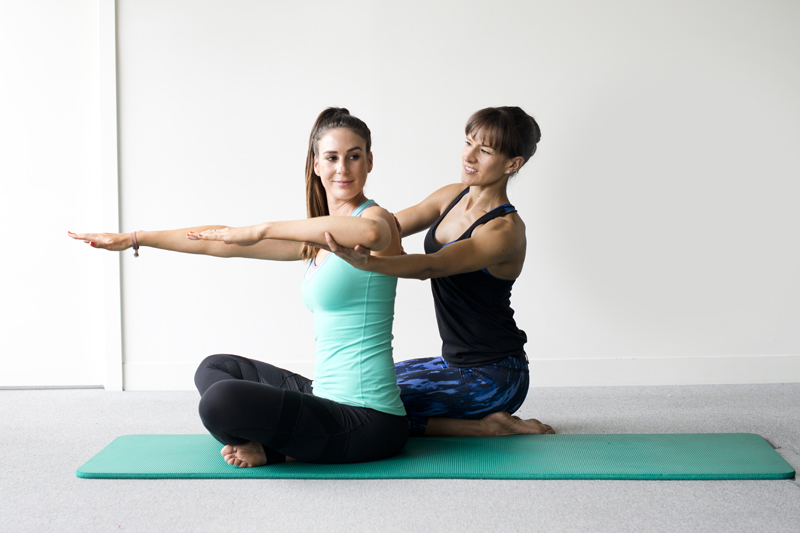Pilates Mat Exercises for all Stages of Frozen Shoulder
Pilates Mat Exercises for all Stages of Frozen Shoulder
by Susan Czyzo (Bachelor of Physical Education and Health, Master of Science in Physical Therapy)Stages of Frozen Shoulder
Stage 1 - Freezing Timeframe: 3 to 9 months Main characteristics: pain with movement in multiple directions, gradual loss of ROM in all directions, unable to sleep on affected side Stage 2 – Frozen Timeframe: 9 to 15 months Main characteristics: loss of ROM, stabilizes, pain decreases, function very limited. Stage 3 – Thawing Timeframe: 15 to 24 months Main characteristics: gradual return of ROM, persistent stiffness Mat Pilates Exercises can be used to target scapulothoracic mobility and stability, spinal mobility, and pelvic stabilityLateral Ribcage expansion
Main purpose: ribcage mobility, pain relief Starting position: Supine with pelvis and spine neutral. Knees flexed to 90 degrees with feet hip-distance apart. Hands placed at sides of ribcage. Sequence: Inhale through your nose and feel the ribcage expand laterally into your hands. Exhale through pursed lips and feel the ribcage and abdomen return to neutral. Repetitions: 10 Stage(s): 1 through 3.Scapular Isolations – Elevation/Depression in crook-lying on foam roller
Main purpose: scapulothoracic mobility Starting position: Supine on foam roller with knees flexed to 90 degrees. Pelvis and spine neutral. Arms long at sides, palms down and resting on soft Pilates balls on either side of the roller. Sequence: Inhale and slide shoulders up to ears. Exhale and slide shoulders down the back, gently reaching your fingertips towards your feet. Repetitions: 10 Stage(s): 1 and 2. Progress to quadruped in late stage 3.
Scapular Isolations – Protraction/Retraction in side-lying with soft Pilates ball
Main purpose: scapulothoracic mobility Starting position: Side-lying (on unaffected side) with knees flexed to 90 degrees. Pelvis and spine neutral. Top arm outstretched and resting on soft Pilates ball or on foam roller (positioned parallel to your body). Sequence: Inhale to prepare. Exhale and reach the top arm forward as you roll the ball/roller away from you. Allow the scapula to glide towards your armpit as you arm moves away. Inhale to pause. Exhale to roll the ball/roller towards you, gliding the scapula back towards the spine. Elbow remains straight throughout the exercise. Repetitions: 5 Stage(s): 1 and 2. Modify shoulder flexion angle as necessary. Thoracic rotation can be added for spinal mobility. Same movement can be performed on the unaffected side in supine, sitting or standing.Seated Spine Twist with Arms Crossed
Main purpose: spinal mobility, postural awareness Starting position: Seated upright with pelvis and spine neutral. Legs long and abducted shoulder-distance. Arms folded across the chest. Sequence: Inhale to prepare. Exhale for three counts as you rotate right. Inhale to return to the centre and repeat to the left. Keep both sit bones grounded throughout the exercise. Repetitions: 3-5 per direction Stage(s): 1 through 3. Progress to arms abducted to 90 degrees as ROM returns in stage 3. In late phases, progress to Thread the Needle in quadruped.Roll-down from Wall
Main purpose: spinal mobility, postural awareness Starting position: Standing with back against wall, feet hip-distance apart, one foot-length from the wall. Spine and pelvis neutral. Arms relaxed at sides or folded across chest. Sequence: Inhale to prepare. Exhale and peel your body off the wall, one vertebrae at a time, starting from the top of the head. Allow the pelvis to roll forward off the wall once the spine is fully flexed. Inhale to hold. Exhale to bring the pelvis back to neutral and stack your spine back up to standing, one vertebrae at a time. Repetitions: 3-5 Stage(s): 1 through 3.Want to know more? Complete the APPI Matwork Certification Series and equip yourself with the skills to deliver clinical Pilates and rehab services to your patients either in a 1:1 or group setting. The APPI Pilates Method has been designed by Physiotherapists for allied health professionals to teach safe and effective Pilates within the clinical environment.
For more info on the APPI Matwork Certification Series click here
Reference Kelley, M. J., Shaffer, M. A., Kuhn, J. E., Michener, L. A., Seitz, A. L., Uhl, T. L., Godges, J. J., & McClure, P.W. (2013). Shoulder pain and mobility deficits: Adhesive Capsulitis. Journal of Orthopaedic and Sports Physical Therapy, 43(5), A1-A31. Retrieved from http://www.jospt.org/doi/pdf/10.2519/jospt.2013.0302
